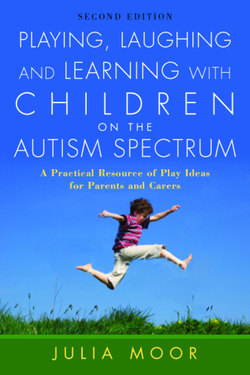Читать книгу Playing, Laughing and Learning with Children on the Autism Spectrum - Julia Moor - Страница 24
На сайте Литреса книга снята с продажи.
Individual example: Sam
ОглавлениеSam was three years old and recently diagnosed with an autism spectrum disorder. Since the diagnosis, Sam’s parents had been working on increasing his eye contact and generally gaining his attention with some simple play activities. Sam had very few words that he used consistently, but his parents felt he was actually quite bright and able. They believed that it was his hyperactivity and rigid routines which were preventing him from learning. They had started to help him communicate with a picture diary and had created a box containing a variety of learning activities that was to be brought out after breakfast (a time when Sam seemed to be at his best) every day. They took a photo of the box and gave it the label ‘workbox’. They also had a picture card for television, which they were using as a reward (Sam liked to watch a particular video over and over). At first Sam resisted having to sit, but when he realized the first session was for only one minute he became compliant enough to sit for ten minutes by the end of the first week.
In the box were:
a shape-matching puzzle
four photos of familiar people and animals (his brother Tom, Daddy, Grandma, Fluffy) – Sam was asked to ‘give Mummy Fluffy’, etc.
a furry toy dog and a brush – Sam was asked to brush dog’s nose, ears, feet, tail, etc.
After he had completed each activity, Sam put the item(s) back in the box. After the final one he was ‘rewarded’ with his video. Sam always resisted spontaneously being directed in this way outside the workbox session, but actually looked forward to the sessions (and their rewards!) when he knew it was going to happen. For two years, until Sam started school, he continued the daily sessions. By the time he was five he was completing two twenty-minute sessions a day in which he was recognizing written words, making story sequences with sequencing picture cards, categorizing objects and building on reasoning skills. During this period they went through times when he occasionally refused to comply; if this happened then the reward was changed and the activities rethought, or sometimes Sam just needed a couple of days off !
These structured learning sessions are not the only times for learning. Modelling correct behaviour and language and creating opportunities to communicate should be done throughout the day, but often it is difficult for a child with autism to spontaneously attend to what you are saying in order to listen and learn. At the table you have a few minutes when you really ‘have him’, and the structure and predictability of this connection feels less stressful for him than being randomly invaded. Always be responsive when your child initiates an interaction (verbal or otherwise) at other times during the day.
